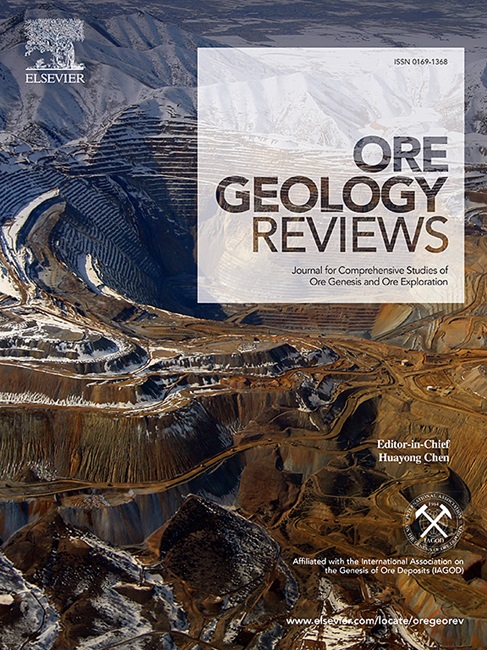Semi-supervised graph convolutional networks for integrating continuous and binary evidential layers for mineral exploration targeting
IF 3.2
2区 地球科学
Q1 GEOLOGY
引用次数: 0
Abstract
Effectively integrating evidential layers of different data types from multi-disciplinary geosciences to predict mineral prospecting targets is the crucial step for mineral exploration. Because the commonly used evidential layer integration method, such as statistical methods and machine learning methods, can only deal with the evidential layers of the same data type, divergent data types must be transformed into the same data type that the evidential layer integrating method can handle. However, the data type transformation inevitably results in the loss of some information in the original data type. To solve this problem, a semi-supervised graph convolutional networks (SSGCN) for graph-structured data classification in machine learning field was adopted to integrate binary and continuous evidential layers to predict mineral prospecting targets. A case study of mineral exploration targeting was carried out in the Lalingzaohuo area, Qinghai Province, China. The mineral exploration data collected during the 1:50,000 geological survey was used to train a SSGCN classification model to predict polymetallic prospecting targets. The input graph-structured data of the SSGCN model is composed of an adjacency matrix and a feature matrix. To test whether a high-performance SSGCN classification model can be established for integrating continuous and binary evidential layers in mineral exploration targeting, in this study, the adjacency and feature matrices were constructed using (a) continuous geochemical evidential layers, (b) binary geological and geophysical evidential layers, (c) binary geological, geophysical and geochemical evidential layers, (d) continuous geochemical evidential layers and binary geological and geophysical evidential layers, (e) continuous geochemical evidential layers and binary geological, geophysical and geochemical evidential layers, and (f) binary geological, geophysical, geochemical evidential layers and continuous geochemical evidential layers. Accordingly, the six SSGCN models were built and used to predict polymetallic prospecting targets. In terms of the receiver operating characteristic (ROC) curves, the performances of the six SSGCN models from high to low are, respectively, models (e) (c), (d), (a), (f) and (b). The area under the ROC curves of the six SSGCN models from high to low are, respectively, (e) 0.9489, (c) 0.9457, (d) 9080, (a) 0.9039, (f) 0.8717 and (b) 0.8453. The polymetallic prospecting targets predicted by the six SSGCN models occupy, respectively, 22.43 %, 8.12 %, 12.93 %, 7.99 %, 7.60 %, 24.16 % of the study area; and correctly classified known polymetallic deposits are, respectively, 88 %, 71 %, 88 %, 82 %, 88 % and 88 %. These results show that the SSGCN model performs best in predicting polymetallic prospecting targets when the continuous geochemical evidential layers are used to construct the adjacency matrix and the binary geological, geophysical and geochemical evidential layers are used to construct the feature matrix. Therefore, it is viable to use the SSGCN algorithm to integrate continuous and binary evidential layers to predict mineral prospecting targets.
用于整合连续和二进制证据层的半监督图卷积网络,以确定矿产勘探目标
有效整合多学科地球科学不同数据类型的证据层来预测找矿目标是矿产勘探的关键步骤。由于常用的证据层整合方法,如统计方法和机器学习方法,只能处理相同数据类型的证据层,因此必须将不同数据类型转化为证据层整合方法所能处理的相同数据类型。然而,数据类型转换不可避免地会导致原数据类型中某些信息的丢失。为了解决这个问题,我们采用了机器学习领域中用于图结构数据分类的半监督图卷积网络(SSGCN)来整合二进制和连续证据层,从而预测找矿目标。在中国青海省拉林措霍地区开展了一项矿产勘探目标定位案例研究。在 1:50,000 地质调查中收集的矿产勘探数据被用于训练 SSGCN 分类模型,以预测多金属找矿靶区。SSGCN 模型的输入图结构数据由邻接矩阵和特征矩阵组成。为了测试能否建立一个高性能的 SSGCN 分类模型,以整合矿产勘探目标中的连续和二元证据层,本研究使用以下数据构建了邻接矩阵和特征矩阵:(a) 连续地球化学证据层;(b) 二元地质和地球物理证据层;(c) 二元地质、地球物理和地球化学证据层、(d) 连续地球化学证据层和二元地质和地球物理证据层,(e) 连续地球化学证据层和二元地质、地球物理和地球化学证据层,以及 (f) 二元地质、地球物理、地球化学证据层和连续地球化学证据层。据此,建立了六个 SSGCN 模型,用于预测多金属找矿靶区。从接收者操作特征曲线(ROC)来看,六个 SSGCN 模型的性能从高到低分别为模型(e)(c)、(d)、(a)、(f)和(b)。六个 SSGCN 模型的 ROC 曲线下面积从高到低分别为(e)0.9489、(c)0.9457、(d)9080、(a)0.9039、(f)0.8717 和(b)0.8453。六个 SSGCN 模型预测的多金属找矿靶区分别占研究区面积的 22.43%、8.12%、12.93%、7.99%、7.60% 和 24.16%;已知多金属矿床的正确分类率分别为 88%、71%、88%、82%、88% 和 88%。这些结果表明,当使用连续地球化学证据层构建邻接矩阵,使用二元地质、地球物理和地球化学证据层构建特征矩阵时,SSGCN 模型在预测多金属找矿目标方面表现最佳。因此,使用 SSGCN 算法整合连续和二元证据层来预测找矿目标是可行的。
本文章由计算机程序翻译,如有差异,请以英文原文为准。
求助全文
约1分钟内获得全文
求助全文
来源期刊

Ore Geology Reviews
地学-地质学
CiteScore
6.50
自引率
27.30%
发文量
546
审稿时长
22.9 weeks
期刊介绍:
Ore Geology Reviews aims to familiarize all earth scientists with recent advances in a number of interconnected disciplines related to the study of, and search for, ore deposits. The reviews range from brief to longer contributions, but the journal preferentially publishes manuscripts that fill the niche between the commonly shorter journal articles and the comprehensive book coverages, and thus has a special appeal to many authors and readers.
 求助内容:
求助内容: 应助结果提醒方式:
应助结果提醒方式:


